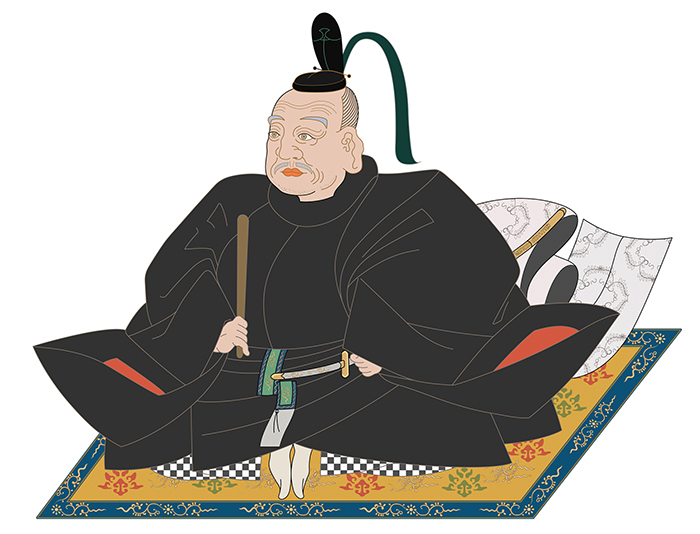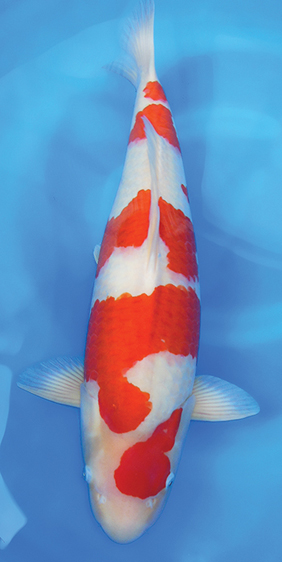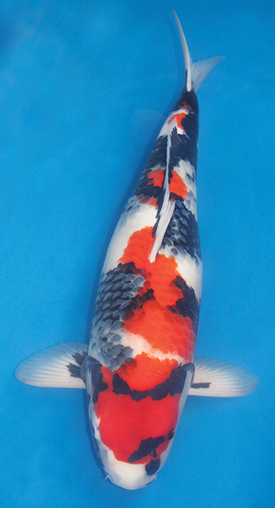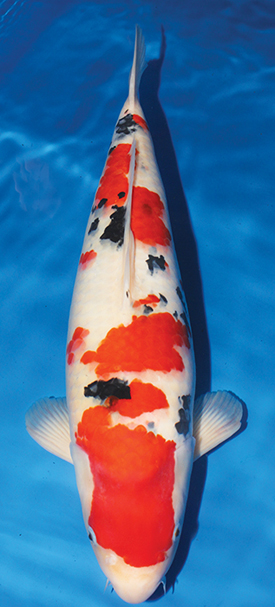
The term “Gosanke” in the koi world refers to the three main varieties: Kohaku, Taisho Sanshoku (Sanke) and Showa Sanshoku (Showa). Although there are more than 100 varieties of koi, these three varieties stand apart from the others for their excellence, perfection and popularity. It is no exaggeration that these varieties are well representative of most Japanese koi.
The word gosanke literally means “the three families” in Japanese. In fact, Gosanke is not a unique term to koi. It is often used to refer to the “big three,” or the three main things that represent a group. One might say that Harvard, Yale and Princeton are the Gosanke of Ivy League schools, but of course, that’s debatable.
Historically, Gosanke referred to historic families in Japan going back to the Edo period (1603 – 1867). This is the time when Tokugawa shogunate, started by Tokugawa Ieyasu, was governing Japan. During this era, the eldest son of the shogun family was supposed to take over the shogun position in principle. But in this case, however, the Tokugawa shogun family had no son to take over.The feudal lords of Owari, Kii and Mito were the three major Tokugawa branch families descended from the three sons of Tokugawa Ieyasu. They were ranked above all the other feudal lords. The three families were called Gosanke. Ever since then, any three in a group that are more important than the others are called the gosanke in Japan. Kohaku, Sanke and Showa are surely the Gosanke in the koi world.
Kohaku

As it is often said, “It begins with Kohaku and ends with Kohaku.” Kohaku is the foundation of every koi variety. There are four things to check on Kohaku: body, quality, pattern and the breeder.
Body is the most important factor in koi. Although it does not matter if they are small, once they have grown up, how the body is constructed makes big difference in beauty. The ideal body conformation is often described as a tree trunk, with a big head, strong body and thick tail joint.
In checking quality, make sure to check shiroji, hi and kiwa. Shiroji, or white ground, is like the canvas of a work of art. Snow white is the ideal color. Hi, or red colors, need to be consistent. Kiwa, or edges, must be sharp.
The balance of the red and white pattern is very important. Hi should begin with the head, move to the body and stop at the tail. The stop at the tail is called odome. How hi stops there is very critical. A stepped pattern is considered optimal. A round spot on the head is always very popular.
Finally, checking breeders is critical, especially in the Kohaku variety. Because a koi is a growing beauty, it is important to envision the future. What looks beautiful now does not guarantee beauty in future. Knowing the breeders is probably the biggest key. Simply coming from Japan is no longer enough. You must know and investigate which breeder you are dealing with.
Taisho Sanke & Showa
Taisho Sanke refers to three-colored koi, or Kohaku with sumi (black) spots or a bekko pattern. Taisho Showa, by comparison, is three-colored koi with a dynamic sumi or Shiro Utsuri pattern. When you look at either koi, you must check the Kohaku, the sumi and the breeders.

Because Sanke is Kohaku with sumi spots, we first examine the excellence of Kohaku. Check its body, quality and pattern. Although pattern is also important in Showa, it is not as important to have a perfect Kohaku pattern as it is in Sanke.
The quality and location of sumi determines the excellence of Sanke. The term “sumi” originally came from calligraphy, referring to black ink. So the quality of the sumi color needs to be as thick and deep as black ink. The location of sumi is delicate. It needs to stay in balance with hi pattern. In Showa, sumi develops massively and dynamically. Even though it may be lacking in some parts of the Kohaku pattern, sumi could appear to maintain a good balance. It is more important to predict what kind of sumi quality will appear and where.
As far as breeders go, the bloodline is very critical whether you are shopping for Sanke or Showa. If there is no good bloodline, there is no future for the koi.
Value of Rarity

When you are showing koi to your customers, it is unlikely that you show only one variety. It’s so easy to find beauties in each variety and so difficult to decide which one to pick. As long as we can carefully examine its body conformation, quality, pattern and breeders, we will know which koi is the best in each variety. But when you pick the best of each, how might you decide which one is the best of the three?
It is not an easy task, almost like comparing apples and oranges. In fact, apples and oranges may be easier, because you can pick your preference. But in koi, there is a rule of the value of rarity. What is rare is more valuable. So if Kohaku, Sanke and Showa are all equally beautiful, we must pick Sanke for the best value.
Breeding beautiful Sanke is more difficult than Kohaku and Showa. And because it is difficult, there are not many Sanke breeders. Their production is much smaller than that of Kohaku and Showa.
Judging koi at a show is a bit of a different story. We generally do not know bloodlines, and we judge based on how the koi look on that day, at that time. Future potential is not as important. But when it comes to extremely close competition, the value of rarity will almost always come into play.
Indeed, Showa currently seems to be the most popular among the three. I see many Showa win grand champions at koi shows. Even in my retail and wholesale divisions, Showa has a higher demand. Many breeders in Japan breed Showa now, too. Interestingly enough, Showa used to be the rarest variety about 20 years ago when I first joined my father’s company. Needless to say, the power balance of the three families (Kohaku, Sanke and Showa) has changed over the years, and it will be interesting to watch the trends of the future.


